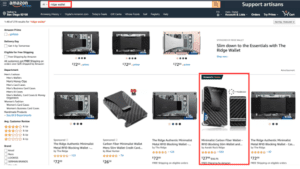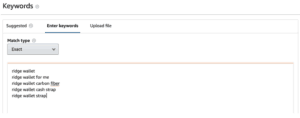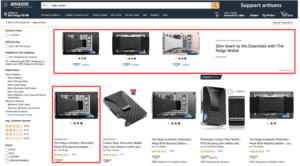
Chris Montenegro, marketplace manager, Digital Operative
When it comes to Amazon advertising, there are two main keyword targeting strategies to employ: offense and defense. These two strategies, while simple in concept, can be utilized in more elaborate ways.
How a brand uses these techniques is dependent on their goals, but with the right strategic mix these techniques can produce results that will continue to both, increase sales and protect your brand inside Amazon.
Offensive Amazon Strategies
Playing offense means targeting branded competitor keywords in your sponsored products’ campaigns. The goal is to target competitors’ keywords so that if a customer searches for the competitor they will be served an ad from you on the search results page. This is a tactic we recommend all sellers to do. But what’s the benefit, is it sustainable, and is there a bigger picture?
The benefit of targeting your competitor’s keywords is that your products will show up to their searching customers, which creates an opportunity to steal that customer away. This is a great way to build your brand on Amazon and help bring in sales, but it can be tricky to achieve a positive ROI. The customer is already searching for your competitor which means they already could be at the bottom of the funnel and making a purchasing decision. Dependent on the CPCs of the branded keywords and your conversion rate, this could yield low ROI or negative ROI.
What’s the end game?
When targeting your competitor’s keywords, ultimately the goal is to drive sales. But in order to drive sales and profitability, the real goal is to get your products to begin to organically rank for your competitor’s keywords. When you begin to rank organically for those keywords, this will drive organic sales without the need for advertising.

Take a look at this example above.
When you search Ridge Wallet on Amazon, the second organic result is a competitor, while the third result is a Ridge Wallet. The reason why this competitor is showing up as number two in the search results is that they have done an excellent job in targeting Ridge Wallet keywords in their advertising campaigns and are seeing sales from it.
The sales from these branded campaigns drive relevancy for Ridge Wallet-branded keywords, which allows the competitor to appear higher. This means that the competitor is outselling Ridge Wallets’ own products when a customer is searching for their brand.
How do I do this?
Let’s say you are selling wallets, to keep the example going, and you want to target a very similar competitor, for example, Ridge Wallet. We will need to find what branded keywords customers are searching for, and use those in our advertising campaigns. This can easily be done using the Amazon search bar and typing in the brand name. Amazon will suggest the most popular keywords for this product.

Once you have these branded keywords, you want to create an ad campaign targeting those keywords. You will want to monitor impressions and increase bids amount if impressions are low.

When you first begin to target a competitor’s keywords, you can expect ACOS [Advertising Cost of Sale] to be relatively high. When considering this strategy, one must take into account the ultimate goal, which is to rank for your competitor’s keywords. Do realize that it costs money to get there. Consider the ad spend going into this strategy as an investment that will ultimately drive organic sales in the future.
Defensive Amazon Strategies
Now that we talked about offense and how you can rank for your competitor’s keywords, let’s talk about how to protect you from your competitors doing the same thing to you. This is called playing defense.
A defensive strategy on Amazon is one that targets your own branded keywords within your advertising campaigns. This strategy is often overlooked by many sellers because they feel they don’t need to advertise to people who are already searching for their product and that it’s just a waste of money. But we just talked about how your competitors can bid on those keywords, steal your sales, and then rank for your branded keywords thus stealing more sales in the future. Still think it’s a waste?
Do a search for your branded keywords on Amazon and see if any competitors are ranking higher than your own products. If yes, then those competitors are stealing your customers.
How do I prevent this?
In order to prevent this from happening, a brand needs to know which keywords their customers are using to find them. You could use the same search bar technique we talked about in the offensive strategy to find these keywords. The more detailed you are in finding these keywords the better affect your campaigns will have protecting you against the competition.

Here we use the same Ridge Wallet example, again. Ridge Wallet is bidding on their own key terms and we know this because we see both a headline search ad and a sponsored product ad for the Ridge Wallet keyword.
Bidding on your branded keywords is usually a lot cheaper than bidding on non-branded keywords and has a low ACOS, as customers are already searching for your product. The goal of a defensive strategy is to set the bids high enough on your branded keywords that your competitors cannot financially afford to bid on them. This requires incremental increases in the bids to find the price at which your competitors are unwilling to compete.
Sounds straightforward, right? It is, so go set it up today.
Wrap it Up
The Amazon advertising platform is constantly evolving, opening up new advertising opportunities to sellers. The most successful brands on Amazon will adapt to these new changes and use them to capture market share and steal sales away from their competitors. As Amazon’s advertising continues to evolve, it’s critical that sellers are leveraging the advertising strategies we described above as well as testing out new options available. Being stagnant with your Amazon advertising strategy is no way to compete in a marketplace that constantly changes.
Digital Operative is a digital marketing agency.
Favorite
